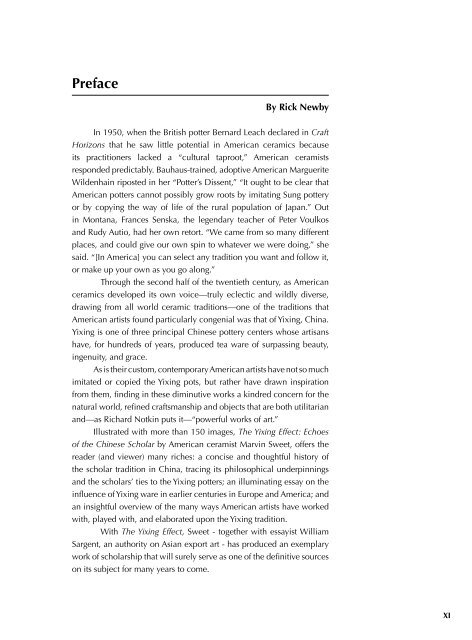THE YIXING EFFECT - Marvin Sweet
THE YIXING EFFECT - Marvin Sweet
THE YIXING EFFECT - Marvin Sweet
Create successful ePaper yourself
Turn your PDF publications into a flip-book with our unique Google optimized e-Paper software.
Preface<br />
By Rick Newby<br />
In 1950, when the British potter Bernard Leach declared in Craft<br />
Horizons that he saw little potential in American ceramics because<br />
its practitioners lacked a “cultural taproot,” American ceramists<br />
responded predictably. Bauhaus-trained, adoptive American Marguerite<br />
Wildenhain riposted in her “Potter’s Dissent,” “It ought to be clear that<br />
American potters cannot possibly grow roots by imitating Sung pottery<br />
or by copying the way of life of the rural population of Japan.” Out<br />
in Montana, Frances Senska, the legendary teacher of Peter Voulkos<br />
and Rudy Autio, had her own retort. “We came from so many different<br />
places, and could give our own spin to whatever we were doing,” she<br />
said. “[In America] you can select any tradition you want and follow it,<br />
or make up your own as you go along.”<br />
Through the second half of the twentieth century, as American<br />
ceramics developed its own voice—truly eclectic and wildly diverse,<br />
drawing from all world ceramic traditions—one of the traditions that<br />
American artists found particularly congenial was that of Yixing, China.<br />
Yixing is one of three principal Chinese pottery centers whose artisans<br />
have, for hundreds of years, produced tea ware of surpassing beauty,<br />
ingenuity, and grace.<br />
As is their custom, contemporary American artists have not so much<br />
imitated or copied the Yixing pots, but rather have drawn inspiration<br />
from them, finding in these diminutive works a kindred concern for the<br />
natural world, refined craftsmanship and objects that are both utilitarian<br />
and—as Richard Notkin puts it—“powerful works of art.”<br />
Illustrated with more than 150 images, The Yixing Effect: Echoes<br />
of the Chinese Scholar by American ceramist <strong>Marvin</strong> <strong>Sweet</strong>, offers the<br />
reader (and viewer) many riches: a concise and thoughtful history of<br />
the scholar tradition in China, tracing its philosophical underpinnings<br />
and the scholars’ ties to the Yixing potters; an illuminating essay on the<br />
influence of Yixing ware in earlier centuries in Europe and America; and<br />
an insightful overview of the many ways American artists have worked<br />
with, played with, and elaborated upon the Yixing tradition.<br />
With The Yixing Effect, <strong>Sweet</strong> - together with essayist William<br />
Sargent, an authority on Asian export art - has produced an exemplary<br />
work of scholarship that will surely serve as one of the definitive sources<br />
on its subject for many years to come.<br />
XI


